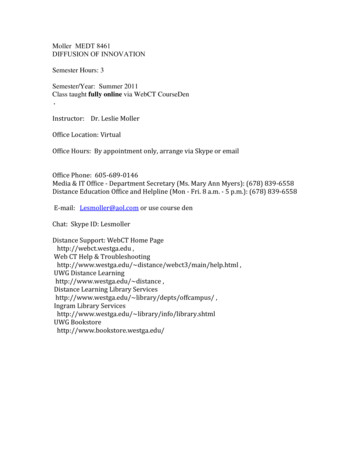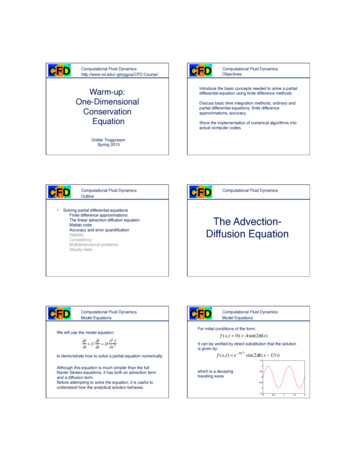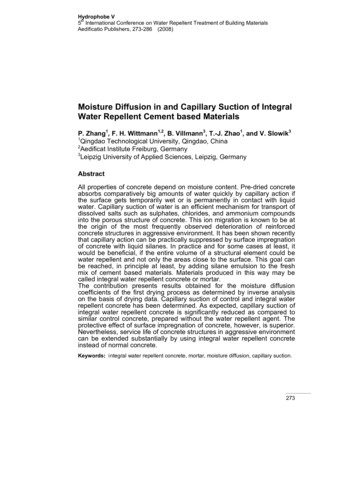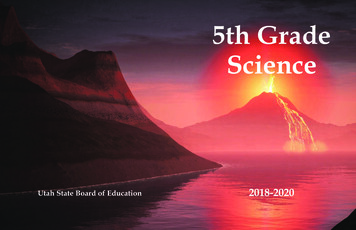
Transcription
Moller MEDT 8461DIFFUSION OF INNOVATIONSemester Hours: 3Semester/Year: Summer 2011Class taught fully online via WebCT CourseDen.Instructor: Dr. Leslie MollerOffice Location: VirtualOffice Hours: By appointment only, arrange via Skype or emailOffice Phone: 605-689-0146Media & IT Office - Department Secretary (Ms. Mary Ann Myers): (678) 839-6558Distance Education Office and Helpline (Mon - Fri. 8 a.m. - 5 p.m.): (678) 839-6558E-mail: Lesmoller@aol.com or use course denChat: Skype ID: LesmollerDistance Support: WebCT Home Pagehttp://webct.westga.edu ,Web CT Help & Troubleshootinghttp://www.westga.edu/ distance/webct3/main/help.html ,UWG Distance Learninghttp://www.westga.edu/ distance ,Distance Learning Library Serviceshttp://www.westga.edu/ library/depts/offcampus/ ,Ingram Library Serviceshttp://www.westga.edu/ library/info/library.shtmlUWG Bookstorehttp://www.bookstore.westga.edu/
COURSE DESCRIPTION(No prerequisites) The course focuses on the processes of innovation and change as theyapply to educational systems. Students learn how to apply change models and diffusiontheory in order to successfully integrate technology-driven procedures and resources intoclassrooms and schools.CONCEPTUAL FRAMEWORKThe conceptual framework of the College of Education at UWG forms the basis on whichprograms, courses, experiences, and outcomes are created. By incorporating the theme“Developing Educators for School Improvement”, the College assumes responsibility forpreparing educators who can positively influence school improvement through alteringclassrooms, schools, and school systems (transformational systemic change). Tendescriptors (decision makers, leaders, lifelong learners, adaptive, collaborative, culturallysensitive, empathetic, knowledgeable, proactive, and reflective) are integral componentsof the conceptual framework and provide the basis for developing educators who areprepared to improve schools through strategic change. National principles (INTASC),propositions (NBPTS), and standards (Learned Societies) also are incorporated as criteriaagainst which candidates are measured. The mission of the College of Education is todevelop educators who are prepared to function effectively in diverse educational settingswith competencies that are instrumental to planning, implementing, assessing, and reevaluating existing or proposed practices. This course’s objectives are related directly tothe conceptual framework and appropriate descriptors, principles or propositions, andLearned Society standards are identified for each objective. Class activitiesand assessments that align with course objectives, course content, and the conceptualframework are identified in a separate section of the course syllabus.COURSE OBJECTIVESStudents will:1. Identify the elements and personnel involved in diffusing an innovation into a socialsystem such as a school or a classroom (Havelock, 1995; Rogers, 1995)(Decision Makers; Leaders; Lifelong Learners; Adaptive; Collaborative; CulturallySensitive; Empathetic; Knowledgeable; Proactive; Reflective; NBPTS 4a, 4b, 5b;ISTE/NTES-T II-b, II- e);2. Give examples of innovation diffusion in various school systems and use diffusiontheory principles to explain why each was successful or unsuccessful (Carson & Smith,1993; Havelock, 1995;Rogers, 1995, Saettler, 1992)(Decision Makers; Leaders; Lifelong Learners; Adaptive; Collaborative; CulturallySensitive; Empathetic; Knowledgeable; Proactive; Reflective; NBPTS 4a, 4b, 5b;ISTE/NTES-T II-b, II- e);
3. Compare and contrast current models of diffusion discussed in the education and socialsciences literature (Havelock, 1995; Rogers,1995; Tenner, 1996; Valente, 1995)(Decision Makers; Leaders; Lifelong Learners; Adaptive; Collaborative; CulturallySensitive; Empathetic; Knowledgeable; Proactive; Reflective; NBPTS 4a, 4b, 5b;ISTE/NTES-T II-b, II- e);4. Identify characteristics of educators who are successful change agents (Havelock,1995; Roblyer & Edwards, 2000; Rogers, 1995,Saettler, 1990)(Decision Makers; Leaders; Lifelong Learners; Adaptive; Collaborative; CulturallySensitive; Empathetic; Knowledgeable; Proactive; Reflective; NBPTS 4a, 4b, 5b;ISTE/NTES-T II-b, II- e);and5. Develop a plan for integrating an innovative technology successfully into a school ordistrict (Carson & Smith, 1993;Havelock, 1995; Rogers, 1995)(Decision Makers; Leaders; Lifelong Learners; Adaptive; Collaborative; CulturallySensitive; Empathetic; Knowledgeable; Proactive; Reflective; NBPTS 4a, 4b, 5b;ISTE/NTES-T II-b, II- e).TEXTS, READINGS, AND INSTRUCTIONAL RESOURCESRequired Text:Ellsworth, J.B. (2000). Surviving change – a survey of educational change models.(ERIC Clearing House on Information and Technology, Syracuse, NY. (ED443417) Thistext is available for download on the WebCT CourseDen course resources page.ReferencesBarr, R., & Parrett, W. (1997). How to create alternative, magnet, and charter schools thatwork. Bloomington, IN: National Educational Service. (ED419266)Beck, C., & Schornack, G. (1998). Understanding educational change: A systems modelapproach. Paper presented at the Second North American Conference on the LearningParadigm, San Diego, CA. (ED420906)Benham, M. (1999). Case studies for school administrators: Managing change ineducation. Lancaster, PA: Technomic Publishing Company, Inc. (ED429332)Birrell, J., Ostlund, M., Eagan, M., Young, J., Cook, P., DeWitt, P., & Tibbitts, C. (1998).Collaboration, communities, and covey: A model for personal and professional change.Clearing House, 71(6), 359-362. (EJ568515)Bohen, S., & Stiles, J. (1998). Experimenting with models of faculty collaboration:Factors that promote their success. New Directions for Institutional Research, 25(4), 3955. (EJ577732)
Brandt, R. (1999). No one best way-but many very good ways. Paper presented at theannual conference and exhibit of the Association for Supervision and CurriculumDevelopment, San Francisco, CA. (ED430732)Brunner, I., & Davidson, B. (1998). The dissemination of educational innovations: Newinsights into the coaching model. Paper presented at the annual meeting of the AmericanEducational Research Association, San Diego, CA. (ED425523)Clark, K. (1996). Human systems engineering: A leadership model for collaboration andchange. Paper presented at the National Conference of the Association for GlobalBusiness, Dallas, TX. (ED401448)Cooper, R., Slavin, R., & Madden, N. (1998). Success for all: Improving the quality ofimplementation of whole-school change through the use of a national reform network.Paper presented at the annual meeting of the American Educational ResearchAssociation, Chicago, IL. (ED420107)Donlevy, J., & Donlevy, T. (1997). Teachers, technology, and training: Perspectives oneducation and school reform-a focus on the sociological perspective. InternationalJournal of Instructional Media, 24(1), 1-14. (EJ569032)Education Commission of the States. (1998). Comprehensive school reform: Criteria andquestions. Denver, CO: Author. (ED428428)Educational Research Service. (1998). Comprehensive models for school improvement:Finding the right match and making it work. Arlington, VA: Author. (ED422632)Ely, D. (1990a). Conditions that facilitate the implementation of educational technologyinnovations. Journal of Research on Computing in Education, 23(2), 298-305.(EJ421756)Fullan, M. (1997). The challenge of school change: A collection of articles. ArlingtonHeights, IL: IRI/Skylight Training and Publishing. (ED409640)Fullan, M., & Stiegelbauer, S. (1991). The new meaning of educational change. NewYork, NY: Teachers College Press. (ED354588)Gaff, J. (1999). General education: The changing agenda; The academy in transition.Washington, DC: Association of American Colleges and Universities. (ED430438)Gelberg, D. (1997). The “business” of reforming American schools. Albany, NY: StateUniversity of New York Press. (ED422637)Gross, S. (1998). Staying centered: Curriculum leadership in a turbulent era. Alexandria,VA: Association for Supervision and Curriculum Development. (ED420094)Hall, G., Wallace, R., & Dossett, W. (1973). A developmental conception of the adoption
process within educational institutions (Report No. 3006). Austin, TX: The University ofTexas at Austin, Research and Development Center for Teacher Education.Hall, G. (1992). The local educational change process and policy implementation. Journalof Research in Science Teaching, 29(8), 877-904. (EJ453551)Havelock, R., & Zlotolow, S. (1995). The change agent’s guide, Second Edition.Englewood Cliffs, NJ: Educational Technology Publications. (ED381886)Havelock, R., Guskin, A., Frohman, M., Havelock, M., Hill, M., & Huber, J. (1969). Acomparative study of the literature on the dissemination and utilization of scientificknowledge. Ann Arbor, MI: Center for Research on Utilization of Scientific Knowledge.(ED029171)Huberman, A., & Miles, M. (1984). People, policies, and practices: Examining the chainof school improvement: Vol. IV. Innovation up close: A field study in twelve schoolsettings-a study of dissemination efforts supporting school improvement. Andover, MA:Network of Innovative Schools, Inc. (ED240716)Khan, B. (1997). The designing matrix: A systemic tool for understanding the visions andimages of new educational systems. Performance Improvement, 36(2), 32-36.(EJ539719)Lawson, H., & Briar-Lawson, K. (1997). Connecting the dots: Progress toward theintegration of school reform, school-linked services, parent involvement and communityschools. Oxford, OH: Institute for Educational Renewal. (ED409696)Lenaghan, D. (1999). Brave new world: A good news scenario for educational reform.(ED430151)Louis, K., & Miles, M. (1990). Improving the urban high school: What works and why.New York, NY: Teachers College Press. (ED327623)MacTaggart, T. (1996). Restructuring higher education: What works and what doesn’t inreorganizing governing systems. San Francisco, CA: Jossey-Bass. (ED408882)Marsh, D. (1999). Preparing our schools for the 21st century: 1999 ASCD yearbook.Alexandria, VA: Association for Supervision and Curriculum Development. (ED427414)Moore, N. (1996). Using the Malcolm Baldrige Criteria to improve quality in highereducation. Paper presented at the Forum of the Association of Institutional Research,Albuquerque, NM. (ED399919)Myers, C., & Simpson, D. (1997). Re-creating schools: Places where everyone learns andlikes it. Thousand Oaks, CA: Corwin Press, Inc. (ED418498)
National Association of College and University Business Officers. (1996). Organizationalparadigm shifts. Washington, DC: Author. (ED402888)New American Schools Development Corp. (1997). Working towards excellence: Resultsfrom schools implementing New American Schools designs. Arlington, VA: EducationalResearch Service. (ED420896)New American Schools Development Corp. (1998). Blueprints for school success: Aguide to New American Schools designs. Arlington, VA: Educational Research Service.(ED420913)Nicholls, G. (1997). Collaborative change in education. Sterling, VA: Stylus Publishing,Inc. (ED408932)Olson, L. (1998). Models for reform. American Educator, 22(3), 18-19. (EJ578727)Plank, D., Scotch, R., & Gamble, J. (1996). Rethinking progressive school reform:Organizational dynamics and educational change. American Journal of Education,104(2), 79-102. (EJ522453)Pourdavood, R., Cowen, L., & Svec, L. (1999). Complexity of school reform: Order andchaos. Paper presented at the annual meeting of the American Educational ResearchAssociation, Montreal, Quebec, Canada. (ED430286)Reigeluth, C., & Garfinkle, R., Eds. (1994b). Systemic change in education. EnglewoodCliffs, NJ: Educational Technology Publications. (ED367055)Roblyer, M. D.(2004). Integrating educational technology into teaching. (3rded.).Columbus, OH: Prentice Hall.Rogers, E.M. (1995) Diffusion of Innovations (4th ed.). New York: The Free Press.Rosenfeld, S., & Gravois, T. (1996). Instructional consultation teams: Collaborating forchange. New York, NY: Guilford Publications. (ED394260)Saettler, P. (1990). The evolution of American educational technology. Englewood, CO:Libraries Unlimited, Inc.Sakofs, M. (1998). Painting and Christopher Columbus: A story about metaphors forschool change. Journal of Experiential Education, 21(2), 108-111. (EJ580360)Schmuck, R., & Miles, M. (1972). Handbook of organizational development in schools.Palo Alto, CA: The National Press. (ED071167)Speck, M. (1996). Best practice in professional development for sustained educationalchange. ERS Spectrum, 14(2), 33-41. (EJ527481)
Squires, D., & Kranyik, R. (1996). The Comer program: Changing school culture.Educational Leadership, 53(4), 29-32. (EJ517889)Stanford, B. (1998). Charting school change: Improving the odds for successful schoolreform. Thousand Oaks, CA: Corwin Press, Inc. (ED418497)Talley, S., & Martinez, D. (1998). Tools for schools: School reform models supported bythe National Institute on the Education of At-Risk Students. Washington, DC: NationalInstitute on the Education of At-Risk Students. (ED418174)Tenner, E. (1996). Why things bite back: New technology and the revenge effect.London, England: Fourth Estate.Tutt, B., & Carter, S. (1999). Understanding and using change forces. Paper presented atthe annual meeting of the American Association of colleges for Teacher Education,Washington, DC. (ED428049)Valente, T., & Rogers, E. (1995). The origins and development of the diffusion ofinnovations paradigm as an example of scientific growth. Science communication, 16(3),242-273. (EJ499788)Valente, T. (1995). Network models of the diffusion of innovations. Hampton, VA:Hampton Press Communication Series.Van de Ven, A., Rogers, E. (1988). Innovations and organizations: Critical perspectives.Communication Research, 15(5), 632-651. (EJ379897)Wallace, B., & Braunger, J. (1998). Teacher stories of curriculum change. Portland, OR:Northwest Regional Educational Lab. (ED424205)Wertheimer, R., & Zinga, M. (1998). Applying chaos theory to school reform. InternetResearch, 8(2), 101-114. (EJ566619)Williams, B. (1997). Initiating curricular change in the professions: A case study innursing. Paper presented at the annual meeting of the American Educational ResearchAssociation, Chicago, IL. (ED411718)Zaltman, G., & Duncan, R. (1977). Strategies for planned change. New York, NY: JohnWiley and Sons.
ACTIVITIES AND ASSIGNMENTS, EVALUATION PROCEDURES, ANDGRADINGPOLICYLink to Conceptual FrameworkThe focus of this course is on theory and practice of diffusing technological innovationswithin a school system. In addition to studying diffusion theory, students report on how apast innovation was diffused and create a diffusion plan or project for a new innovation.The overall evaluation for this course is structured on completing individual readings aswell as report on a past diffusion and a new diffusion plan. Due to the broad nature of thecourse, each conceptual framework descriptor is covered in the various courseassignments.As students complete their assignments, they will have demonstrated achievement in theareas of decision making:selecting topic areas in the student’s field of study to design and develop an innovationplan (course activities 2.1-2.2, 3.1-3.4);leadership: enhancing his/her knowledge and skills in diffusion in order to integratetechnology more extensively on-the-job and to assist others as needed. (course activities2.1-2.2, 3.1-3.4);lifelong learning: studying how to integrate technology into the work place (courseactivities 1, course activities 2.1-2.2, 3.1-3.4);being adaptive: changing educational practices to meet the needs of learners (courseactivities 2.1-2.2, 3.1-3.4);collaboration: working with colleagues and stakeholders to plan and carry out schoolimprovements in technology (course activities 2.1-2.2, 3.1-3.4);cultural sensitivity: adapting interventions and technology innovations to meet the needsof diverse learners (course activities 2.1-2.2, 3.1-3.4);empathy: demonstrating sensitivity to the needs of individual, family, and communityneeds (course activities 2.1-2.2, 3.1-3.4);knowledge: drawing on pedagogical, content, and professional knowledge, includingknowledge from others’ postings in the online bulletin board when developing diffusionplans (course activities 2.1-2.2, 3.1-3.4);being proactive: implementing new interventions and innovations in technology to betterserve learners (course activities 2.1-2.2, 3.1-3.4) and
reflection: engaging in ongoing, continuous reflection related to technology to determinethe effectiveness of interventions/ innovations and school changes that are needed tomore effectively integrate technology into the curriculum (course activities 2.1-2.2, 3.13.4).Activities and Assessments:2.0 Weekly Work2.1 Module Discussions (5 modules @ 11 points each 56)In each module, the student will respond to a discussion prompt(s) provided by theinstructor. With a few exceptions, the student is expected to make an initial posting onor before Wednesday of that week and follow up with remaining postings during theweek. Students are expected to read and participate in all online discussions. Eachdiscussion (except where noted elsewhere) is worth 8 points. You are required to postyour initial thoughts (4pts) and respond to AT LEAST two other postings (4pts). Areflective response includes new information, personal perspectives, or other input thatshows thought and consideration of the issue. It goes beyond simple agreement orendorsement of responses that have already been posted. (Course Objectives 1, 2, 3, 4;Teacher Observation, WebCT BB postings, Online discussions)2.2 Quizzes (36 points)There will be a short quiz of no more than nine questions made available thoughWebCT on that module’s readings. Please consult the tentative course schedule foreach week’s readings. The number of points will vary depending on the number ofchapters which are required for that week.(Course Objectives 1, 2, 3, 4, 5; WebCTQuizzes). Quizzes can be taken at your convenience provided they are all completedby 7/18 2011Student WorkAll student work submitted during the course is required to be original. All projects mustbe completed to be graded.3.1 Project 1: The Interview (10 points)The student will locate an individual(s) whose job responsibility it is to facilitate thetechnology integration process into an educational setting and interview that person. Thestudent may conduct the interview in any format they choose (FTF, email, phone, chat,etc). Upon completion of the interview, the student is to create a PowerPoint presentation,videocast, podcast, etc that contains the highlights from the interview. The student mustpost this presentation to the appropriate WebCT CourseDen Assignment Dropbox forgrading. (Course Objectives 1, 4, 5; rubric).
3.2 Project 2: Diffusion and Adoption Reflection (15 Points)The student will identify an educational innovation, which they personally witnessed.The student will provide a detailed description of the setting in which the change tookplace, the personnel involved and an analysis of the success (or failure) using one of thechange models presented in the class as a guide. (Course Objectives 1, 2, 3, 4; rubric).3.3 Project 3: Interviewing Stakeholders (15 points)The student will locate a student and/or a parent of a student and interview that person(s)concerning the technology integration at their school. The student may conduct theinterview in any format they choose (FTF, email, phone, chat, etc). Upon completion ofthe interview, the student is to create a PowerPoint presentation, videocast, podcast, etcthat contains the highlights from the interview. The student must post this presentation toWebCT CourseDen Assignment Dropbox for grading.I am flexible about who you interview. Please contact me with your ideas or suggestionsif you are having trouble finding someone to interview. (Course Objectives 1, 4, 5;rubric).3.4 Project 4: CHOOSE ONE!3.4a Hands-on Technology (40 Points):You may crea
(No prerequisites) The course focuses on the processes of innovation and change as they . resources into classrooms and schools. CONCEPTUAL FRAMEWORK The conceptual framework of the College of Education at UWG forms the basis on which programs, courses, experiences, and outcomes are create











